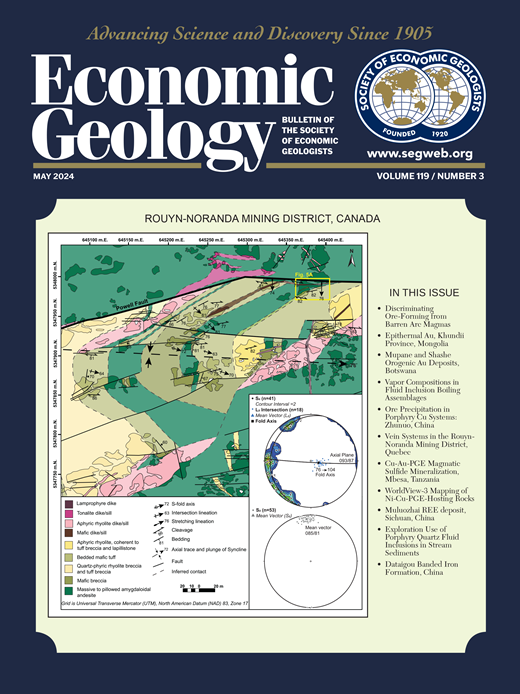海基和岩浆热液体系蚀变火山岩的稀土元素迁移率和Sr同位素系统:克马德克弧兄弟火山(IODP 376)
IF 4.9
1区 地球科学
Q1 GEOCHEMISTRY & GEOPHYSICS
引用次数: 1
摘要
2018年,国际海洋发现计划(IODP) 376号考察队成功钻探了兄弟火山火山口内部和壁上的海水基和岩浆影响的热液系统,兄弟火山是克马德克弧的一座海底活火山。本文报道了从3个孔中恢复的蚀变火山物质的稀土元素丰度和比值,以评估在不同的流体-岩石反应条件下的迁移率和分配。我们将这些数据与燃失量(LOI)和x射线衍射(XRD)数据结合起来记录蚀变程度,并结合Sr浓度和同位素数据来评估水/岩(W/RSr)比,并提供热液交换和蚀变条件的约束条件。在低W/RSr比(1-14)下,从NW破火山口海水热液系统中回收的岩石显示出不同程度的蚀变(LOI值为1-11 wt %),以绿泥石和石英丰富的蚀变矿物组合。我们将观察到的总稀土含量(ΣREE)和球粒陨石归一化稀土模式的有限变化归因于它们与次级矿物(如绿泥石和蒙脱石)的结合以及与反应流体中的氯配体的络合。从受岩浆影响的上锥热液区(以及在NW破火山口壁深处的一个更古老的层段)中恢复的岩石发生了更广泛的变化(LOI值为4至bbb22 wt %),尽管其W/RSr比(~ 1-16)与非均质含钠辉石和叶叶石组合相似。在ΣREE含量较低的情况下,稀土表现出相当大的迁移性,特别是在中稀土和重稀土中(LaN/YbN比高达4)。我们认为,由于它们缺乏稀土的取代位点,次生矿物中的调节不太可能在稀土的行为中起作用。我们将所有稀土元素的迁移性增强归因于非常低的pH值所增加的溶解度,而中重稀土元素的分馏可能是由于与氟化物的络合作用,这提高了它们相对于轻稀土元素的溶解度。本文章由计算机程序翻译,如有差异,请以英文原文为准。
Rare Earth Element Mobility and Sr Isotope Systematics of Altered Volcanic Rocks from Seawater-Based and Magmatically-Influenced Hydrothermal Systems: Brothers Volcano, Kermadec Arc (IODP Expedition 376)
In 2018, International Ocean Discovery Program (IODP) Expedition 376 successfully drilled into seawater-based and magmatically-influenced hydrothermal systems within and on the wall of the caldera of Brothers volcano, an active submarine volcano in the Kermadec arc. We report rare earth element (REE) abundances and ratios for altered volcanic material recovered from three holes to assess mobility and partitioning under the different conditions of fluid-rock reactions. We combine these with loss on ignition (LOI) and X-ray diffraction (XRD) data to document the extent of alteration, and with Sr concentration and isotope data to evaluate water/rock (W/RSr) ratios and provide constraints on hydrothermal exchange and conditions of alteration. Rocks recovered from the seawater-based NW Caldera hydrothermal system show variable extents of alteration (LOI values of 1–11 wt %) at low W/RSr ratios (1–14) to chlorite- and quartz-rich alteration mineral assemblages. We attribute the limited changes observed in total REE content (ΣREE) and chondrite-normalized REE patterns to a combination of their incorporation into secondary minerals such as chlorite and smectite and complexation with chloride ligands in the reacting fluids. Rocks recovered from the magmatically-influenced Upper Cone hydrothermal field (and from an older interval deep beneath the NW Caldera wall) are more extensively altered (LOI values of 4 to >22 wt %), although at similar low W/RSr ratios (~1–16) to heterogeneous natroalunite- and pyrophyllite-bearing assemblages. The REEs exhibit considerably greater mobility with lower ΣREE contents, particularly in the middle and heavy REEs (LaN/YbN ratios up to 4). We suggest that accommodation in secondary minerals is unlikely to play a role in REE behavior due to their lack of substitution sites for the REEs. We attribute enhanced mobility of all the REEs to increased solubility due to the very low pH, and fractionation of the middle and heavy REEs as likely due to complexation with fluoride which enhances their solubility relative to the light REEs.
求助全文
通过发布文献求助,成功后即可免费获取论文全文。
去求助
来源期刊

Economic Geology
地学-地球化学与地球物理
CiteScore
10.00
自引率
6.90%
发文量
120
审稿时长
6 months
期刊介绍:
The journal, now published semi-quarterly, was first published in 1905 by the Economic Geology Publishing Company (PUBCO), a not-for-profit company established for the purpose of publishing a periodical devoted to economic geology. On the founding of SEG in 1920, a cooperative arrangement between PUBCO and SEG made the journal the official organ of the Society, and PUBCO agreed to carry the Society''s name on the front cover under the heading "Bulletin of the Society of Economic Geologists". PUBCO and SEG continued to operate as cooperating but separate entities until 2001, when the Board of Directors of PUBCO and the Council of SEG, by unanimous consent, approved a formal agreement of merger. The former activities of the PUBCO Board of Directors are now carried out by a Publications Board, a new self-governing unit within SEG.
 求助内容:
求助内容: 应助结果提醒方式:
应助结果提醒方式:


